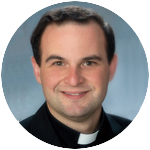
Father Eric J. Banecker
With the COVID-19 pandemic (thankfully) fading into the background here in the United States, I’ve noticed a sudden uptick in the weddings on my calendar. Indeed, between April 1, 2020 and April 1, 2021 I celebrated precisely three weddings. I’ve already celebrated four in the last month, with several more on the docket coming up. (Yes, I am a huge nerd and keep track of these things.)
This, of course, is a very good thing. Marriage – raised by Christ himself to the dignity of the sacrament – is the means by which men and women participate in God’s creation by bringing forth new life. The family – of which matrimony is the defining sacrament – is the vital cell of society.
When a culture decides it has moved past marriage and children, when it ignores the species-defining tug of family life, that culture demonstrates a profound lack of hope. It is a culture with no future, only a short-sighted present. (A recent New York Times article on declining birthrates around the world casts this reality in a stark light.)
[hotblock]
I was reflecting on these things upon returning from North Carolina, where I celebrated a wedding for friends. In the process, with the anniversary of my priestly ordination in mind, I thought about my own vocation. After all, these two sacraments – matrimony and holy orders – possess a certain complementarity to them.
In our traditional tripartite division of the seven sacraments, they are the two that don’t fall neatly into a category. They aren’t sacraments of initiation (through they do depend upon them), nor are they sacraments of healing. They have been called, at various times, “sacraments of mission” or “sacraments at the service of communion” or “sacraments of vocation.”
What links these two states of life – marriage and priesthood – can be witnessed in the nuptial Mass itself. The church, interestingly, instructs that a marriage between two Catholics is ordinarily to take place during the celebration of Mass, if possible.
During the exchange of vows, the groom and bride are truly the celebrants of the sacrament. It is their free and irrevocable consent to take one another “in good times and in bad, in sickness and in health” which constitutes the essential element of the sacrament of matrimony. The priest, in that moment, is a representative of the church who witnesses the exchange of vows in her name.
[tower]
These two ministers, otherwise known as the bride and groom, are joined together by the Holy Spirit for the sake of marital fruitfulness. In a fundamental way this involves the procreation and education of children, which is the most important goal of married life. And yet this fruitfulness does not end there: the mutual good of the spouses themselves is also a fundamental goal of married life.
Christ instituted this sacrament because he knew that it would lead to people’s happiness. He knew that this happiness would be experienced even now (along with the many challenges which are part of marriage), even as we know that the goal of our lives is the eternal wedding feast of the Lamb.
After the exchange of consent, the focus of the liturgy turns from the bride and groom to the altar. During the Liturgy of the Eucharist, all the faithful present turn their attention not to each other, but to the One who created them all and gathers them together in his love.
It is a great paradox that – in the Latin Church, anyway – the Eucharist is celebrated by a celibate man. On a human level, there is nothing about that which bespeaks fruitfulness. And yet, through ordination to the priesthood, this solitary man possesses an unheard-of authority: the ability to speak with the Ego of Christ himself, who says, “This is my body, which will be given up for you.”
Indeed, the fruitfulness which is the goal of matrimony finds its source and origin in the Eucharist, the perpetual memorial of the sacrifice of Christ, who laid down his life for his friends (cf. Jn 15:13). In matrimony, a man and woman say yes to imitating him by dedicating themselves entirely to the good of the other, just as Christ loved the church and gave his life for her (cf. Eph 5:25).
Without the Eucharist, marriage might seem like a noble ideal which, for all its beauty, is impossible in practice. But because of the Eucharist, we know that true self-giving love is possible. We know it because we eat and drink it in Holy Communion. The bride and groom are the very first to receive Communion after the priest himself at a wedding Mass. And it is in that moment, in which the newly married couple receives the Bread of Life from a man who has renounced marriage for the sake of the Kingdom of Heaven, that these two vocations demonstrate their dynamic coherence.
In that light, priests should never view weddings as just another duty (with a lot of paperwork on top of it!). We should remember to appreciate them, as they represent a reminder that the church is ever ancient, ever new. At the same time, good, faithful married couples help us define our own vocations more distinctly, just as we (hopefully) support married couples and remind them of the preeminence of Christ.
May we – priests and married couples together – support one another along our pilgrimage, so that Christ, high priest of the church and her spouse, may live his life in us.
***
Father Eric J. Banecker is pastor of St. Francis de Sales Parish, Philadelphia.
PREVIOUS: For the sake of youths, let’s put on a good, unmasked face
NEXT: The power of words, when necessary



Share this story